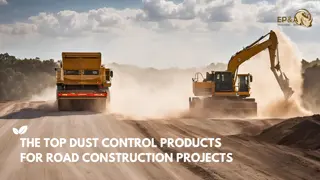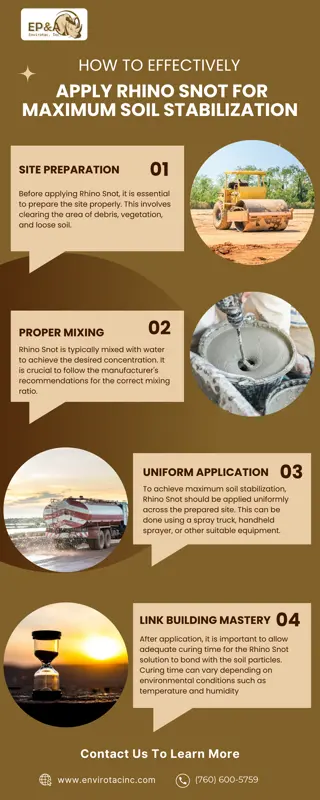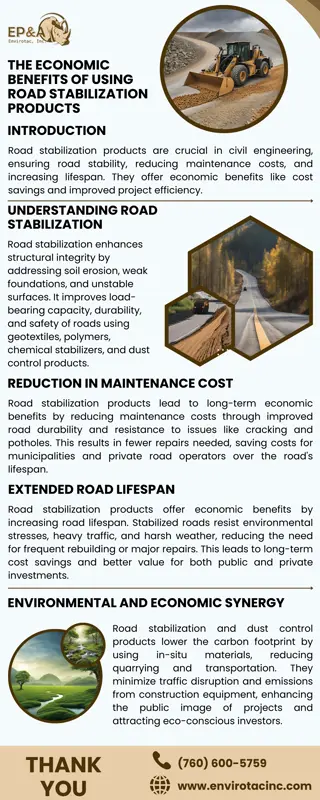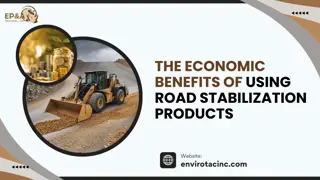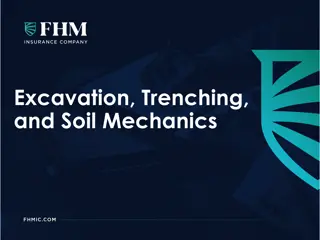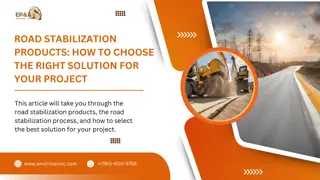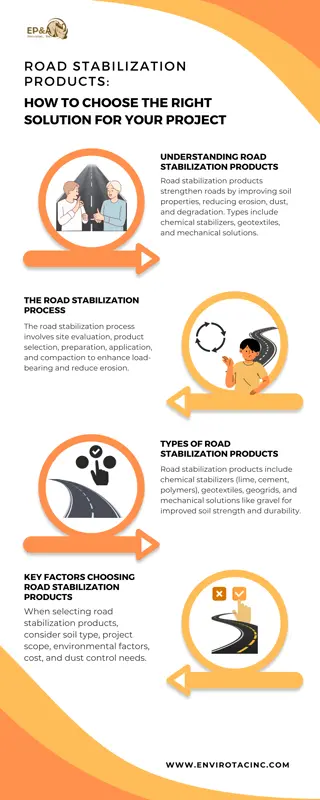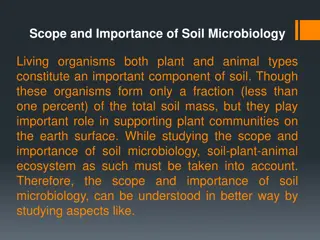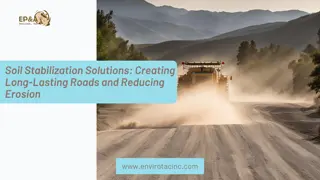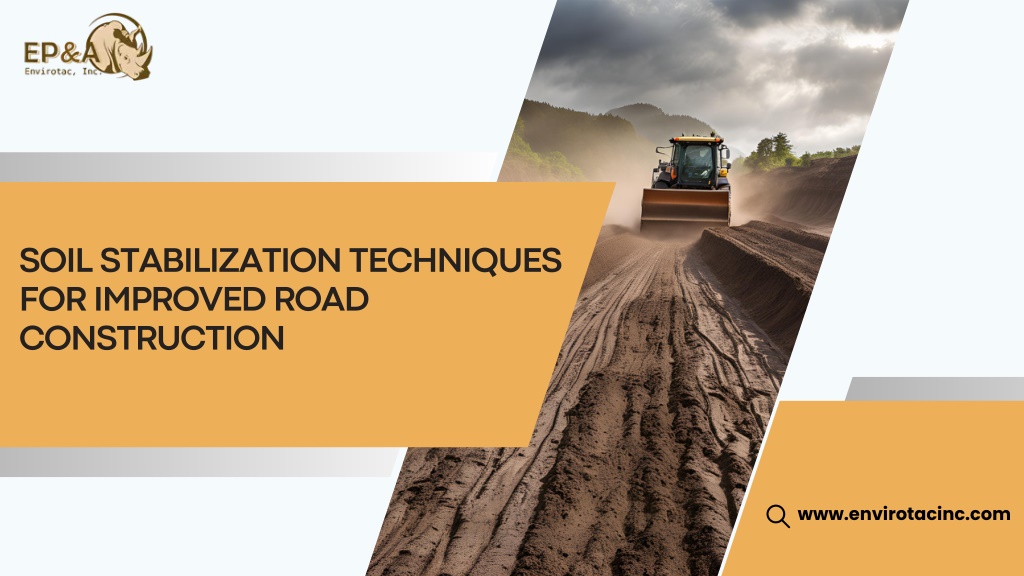
Soil Stabilization Techniques for Improved Road Construction (2)
"Environmental sustainability doesn't mean living without luxuries, but rather living with eyes open and making choices to reduce a little, to waste a little less." - Anonymous.nnThe present times are marked by an enhanced consciousness for prese
Download Presentation

Please find below an Image/Link to download the presentation.
The content on the website is provided AS IS for your information and personal use only. It may not be sold, licensed, or shared on other websites without obtaining consent from the author. Download presentation by click this link. If you encounter any issues during the download, it is possible that the publisher has removed the file from their server.
E N D
Presentation Transcript
SOIL STABILIZATION TECHNIQUES FOR IMPROVED ROAD CONSTRUCTION www.envirotacinc.com
INTRODUCTION "Without infrastructure, society crumbles." This famous saying by Tom Selleck may sound like a little overstatement, but it doesn't lie too far from reality. Consider first the fact that in 2012, FHWA reported there to be more than 1.4 million miles of unpaved roads in the United States, accounting for more than one-third at 35 percent of the country's total road network. Poorly constructed and unstable roads can interrupt the economic lifeblood of communities in ways experienced everywhere, from daily commutes to the way goods are moved. That is where soil stabilization comes in a very critical technique that can transform weak soil into a robust foundation, ensuring the longevity and reliability of roads.
UNDERSTANDING SOIL STABILIZATION TECHNIQUES Soil stabilization is a method aimed at improving the physical properties of soil, enhancing its strength, durability, or load- bearing capacity by adding physical, chemical, or biological agents. In terms of road construction, soil stabilization means a methodology oriented towards providing a solid base capable of withstanding heavy traffic while countering hostile environments. WHAT IS SOIL STABILIZATION?
KEY TECHNIQUES IN SOIL STABILIZATION 01. 02. 03. Mechanical Stabilization Chemical Stabilization Polymeric Stabilization It physically changes the constitution of the soil by mixing it with other materials, mostly gravel or sand. It tries to improve the mechanical properties of the soil, such as its density and cohesion. Introducing additives like lime, cement, or fly ash to soil for modification creates a stable matrix by reacting with natural particles. For example, lime can increase soil pH to form cementitious compounds, improving strength. Polymer-based stabilizers from companies like EP&A and Envirotac Inc. enhance soil resistance to erosion and increase load-bearing capacity. These environmentally friendly products are used for building road infrastructure.
WHY SOIL STABILIZATION IS NECESSARY ENHANCING ROAD DURABILITY Stabilized soil provides a firm base, and this forms the basis of life for the road. More so, the enhanced load-bearing capacity of the soil enables the roads to support heavy traffic without deforming. That is the case in areas of weak or expansive soils, which shrink and swell.
REDUCING MAINTENANCE COSTS Well-stabilized roads require fewer maintenance and repair frequencies. That, in addition to the multifarious advantages enumerated above, will elongate the life expectancy of the road while saving governments and municipalities a lot in terms of cost. As an example, the plasticity index of the soil can be reduced by adding lime to it; this minimizes shrink-swell behavior, hence reducing the occurrence of cracks and potholes. Utilizing soil stabilization services can significantly contribute to these maintenance cost savings.
ENVIRONMENTAL BENEFITS Environmentally friendly stabilizers: Envirotac Inc. offers environment-friendly dust control solutions, thereby reducing the organization's footprint on the environment during the road-making process. These dust control products aim at dust reduction, soil erosion prevention, and lowering the carbon footprint created by conventional methodologies in road building. The use of sustainable materials helps safeguard one's surroundings and promotes greener construction practices.
HOW TO UTILIZE SOIL STABILIZATION TECHNIQUES FOR IMPROVED ROAD CONSTRUCTION SITE ASSESSMENT AND SOIL TESTING The initial step in soil stabilization methods involves assessing and testing the soil to understand its type, moisture content, compaction level, and selecting the suitable treatment method. CHOOSING THE RIGHT STABILIZATION METHOD Experienced engineers or soil stabilization services can assess soil to determine the best approach for a project. Clayey soils may need lime for chemical stabilization, while sandy soils could require mechanical stabilization with aggregates.
APPLICATION PROCESS PREPARATION COMPACTION Clear the site of vegetation, debris, and any unsuitable materials. Level the area to ensure uniform application of stabilizers. After mixing, compact the soil using rollers to achieve the desired density and strength. Proper compaction is vital to eliminate air gaps and ensure a stable foundation. MIXING CURING For chemical stabilization, evenly distribute the chosen additive (e.g., lime, cement) over the soil surface and mix thoroughly using machinery such as rotavators or graders. Allow the stabilized soil to cure, which may involve keeping the soil moist for a specific period to enable chemical reactions to complete. This step is particularly important for chemical stabilization methods.
THANK YOU Visit Our Website www.envirotacinc.com Contact Us (760) 600-5759



